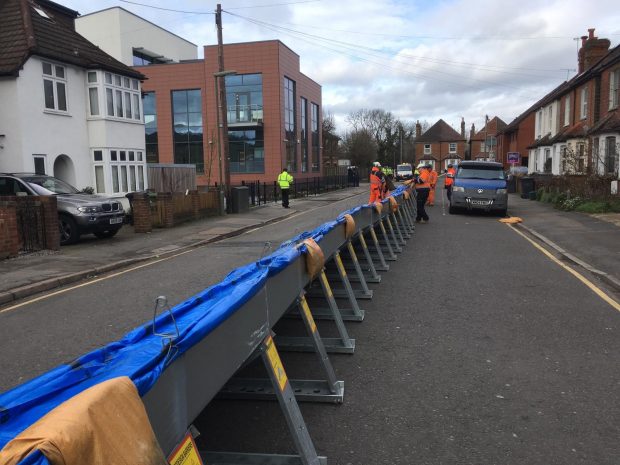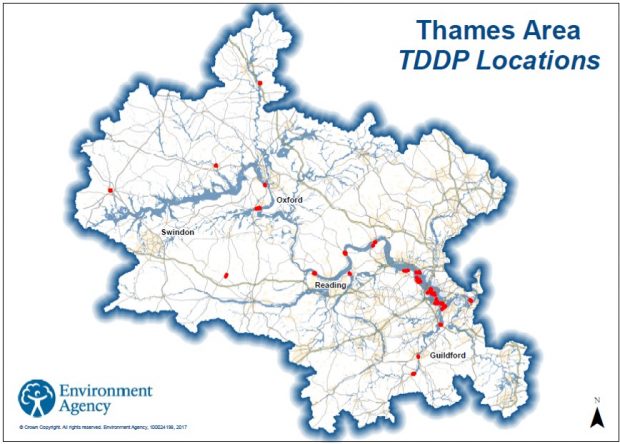
by Tina Donaldson, Environment Agency Flood Risk Advisor in the Thames Area
While permanent flood defences remain central to our strategy to reduce flood risk across England, temporary flood barriers have become a frequent sight on news bulletins, and have a huge part to play as we work to keep communities safe during extreme weather, holding back swollen rivers from people's homes.
What are temporary flood barriers?
Temporary flood barriers consist of portable metal frames with a waterproof cover, designed to be quickly set up in pre-planned locations which do not have permanent defences.
When flooding is expected, the barriers are quickly put up. When the risk has passed, the barriers are taken down, checked over and put back into storage, ready to be used again.
Across England, we have 40,000 metres of temporary flood barriers ready to deploy. Our barriers can be delivered anywhere in the country within 12 hours, and will then be deployed at sites by our operations personnel.
Why and where do we use temporary flood barriers?
The Environment Agency may use temporary flood barriers in places where it isn't possible or practical to build a permanent flood defence (or where one hasn't yet been built).
For example, we often use temporary flood barriers in towns and villages whose economies and communities depend on access to the river (such as riverfront bars and restaurants) where permanent defences would prove too disruptive.
We have detailed deployment plans in place for more than 100 high-risk locations across England. While having these plans in place makes it quicker and easier to deploy the barriers, we may still use barriers in an area where it is technically and physically viable to deploy them and they will prevent flooding.
In addition to temporary flood barriers, we also use demountable defences in some locations. These defences consist of permanent structural foundations, with barriers deployed when there is a risk of flooding. They are used to reduce the visual impact of permanent defences, for example in Bewdley and Shrewsbury on the River Severn, where demountable defences maintain the open vista of the river and open access through the old towns.
Temporary flood barriers in Thames Area

In Thames Area, encompassing the Thames Valley and Surrey, we have identified over 20 locations where a temporary barrier could form part of our response to flooding.
To do this, we assessed the history of flooding in each location, the depth the flood waters are likely to reach, and the time it takes the river to respond to rainfall. We ruled out the use of temporary flood barriers where it wouldn't be safe for the people putting them up and where a barrier would increase flood risk to neighbouring communities.
My work has been to share information with communities in these locations about our plans for a temporary barrier and how it might affect them. I have worked with resident flood groups and community groups, parish councils, local council officers and emergency planners. I listen to their feedback and, if technically feasible, make adjustments to the deployment plan.
We've also carried out trial runs with our emergency response partners, so that everyone involved in putting up temporary barriers knows what to do.
Temporary barriers can form part of the toolkit we use to reduce the risk of flooding from rivers, along with warning and informing the public about flood risk.
To find out whether you live or work in an area at risk of flooding, and what to do if you receive a flood warning, visit https://www.gov.uk/check-flood-risk

7 comments
Comment by Graham Carroll posted on
Graham Carroll retired chartered engineer and consulting engineer.
Rather than holding back high river levels by sloping struts presumably bolted to the ground,is there a system other than flexible barriers whereby the water is held in a linear rigid tank such that one uses the mass of the contained water to give substantially improved stability. They can be demountable for storage
I have done very preliminary sketches and it does appear a feasible method
Please let me know if you feel that this idea might have some traction
Good luck with your current problems
Cheers Graham Carroll
Comment by Judith stephens posted on
I would like to express my concern and dismay at the proposals contained in your recent consultation documents. Whilst new flora and fauna, trees/flowers etc are going to be introduced at what cost to the living things in the area now. There are other processes which could be followed with the upheaval you proposal with a financial saving to boot! I would ask you to reconsider these alternatives and advise why these would not be more viable and a far superior pro- nature process than the damage to nature and excessive costs in your proposals even though the results would be similar.
Comment by J Wainwright posted on
Are flood barriers only available to communities, would you consider protecting solitary buildings which have to deal with increased flooding due to the channeling of flood water by the use of barriers?
My building is a listed pre 16thcentury Boat Inn which has no foundation under the main body of the building. Using sandbags or pumps alone is futile. However, the use of a temporary barrier around the structure could help in the preservation of this historical building and reduce damage caused by the new found forces and levels of flooding.
I would be very interested for your views.
Many thanks
J Wainwright c/o The Camp House Inn, Grimley, Worcester #RiverSevern
Comment by Jody David whittaker posted on
Think we need these temporary flood barriers as weather becoming more extreme and will stop damage to community and infrastructure if build more houses or local services etc
Comment by Peter Cresswell posted on
As J Wainwright above notes, many private householders will have a need of flood defences with increased rainfall, winds, and temperatures being forecast. Will the Agency not supply, sell, rent, or advise such devices as may be suitable of the many available by suppliers? For a single householder the costs of for example a temporary Flood Barrier may be prohibitive, and that of course whether one buys the right one or not.
Comment by Clive Eales-Johnson posted on
I designed a portable foldable flood barrier three years ago for assembly at river banks. It took three years to obtain the UK and European patents. I am looking for a licensee to manufacture and distribute my mitigation device.
Comment by Faye G posted on
Hello sir, I believe you should get in touch with us to discuss how to act on your proposal. We can be reached on 03708506506 or alternatively you can email us on enquiries@environment-agency.gov.uk. Many thanks